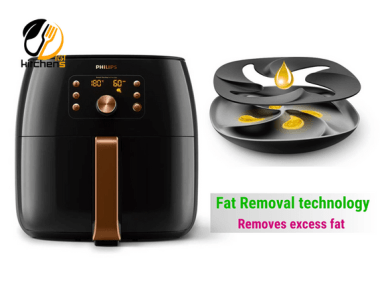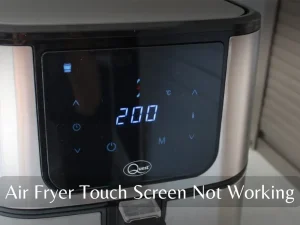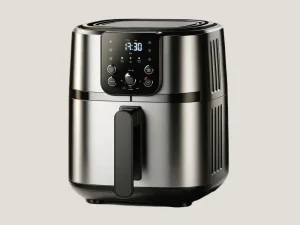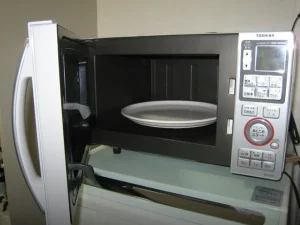In today’s health-conscious world, a common question pops up: Are air fryers toxic? This concern is especially relevant for those who love the convenience and taste of air-fried foods.
They promise crispy food without all the oil, but there are some concerns. This article cuts through the noise to examine what’s really going on inside these handy gadgets.
Are they leaving bad things in our food, or is it a lot of hot air about nothing? Let’s find out and put those worries about toxicity and safety to rest.
Key Takeaways:
- Getting to the bottom of the air fryer safety debate.
- Unpacking how air fryers work – no jargon, promise!
- Eyeing up if there are any nasty chemicals in the mix.
- Serving the truth about non toxic air fryers – as simple as that!
What is an Air Fryer and How Does It Work?

An air fryer is a kitchen gadget that cooks food by blowing hot air around it. It makes food crispy like it’s fried but with way less oil. So, it’s healthier.
It’s like a mini oven but works faster. Inside, there’s a heating element and a fan.
You just put food in a basket, set the time and temp, and it cooks fast. It’s great for fries, chicken, and even veggies.
Air fryers are easy to use and clean, making them popular for quick meals. They come in different sizes, so you can find one that fits your kitchen perfectly.
If you love crispy food but want to eat healthier, an air fryer is a good choice.
The technology behind air frying
Air frying technology is cool and simple. It uses a heating element and a fan. The element heats the air inside the fryer. Then, the fan moves this hot air fast around the food.
This hot air action cooks the food and makes it crispy, like frying but with less oil. So, you get yummy, crispy food that’s healthier. It’s perfect for cooking snacks or meals quickly.
Plus, cleaning is easy. If you love fried food but want to eat healthier, an air fryer is a great choice. You’ll be amazed at how crispy and tasty your food comes out!
Common materials used in air fryer construction
Air fryers are made mostly of plastic and metal. The outside is plastic, so it’s cool to touch. Inside, there’s a metal basket. That’s where the food goes. This basket often has a non-stick layer for easy cleaning.
The part that heats up, the heating element, is usually stainless steel. It’s strong and gets hot quickly. Some air fryers have bits made of aluminum, too.
It’s light and heats up well. So, an air fryer is tough, easy to clean, and cooks food fast.
What Is Teflon?
Teflon, scientifically known as polytetrafluoroethylene (PTFE), is a synthetic material famous for its non-stick properties. It’s commonly used in cookware, like air fryers, making them easy to clean.
However, there’s a growing interest in non teflon air fryers, especially for health-conscious folks.
These alternatives, such as the best stainless steel or non toxic air fryers, offer similar benefits without Teflon. People often seek the healthiest air fryer, focusing on air fryer-safe options.
Thus, an air fryer without teflon or a nonteflon air fryer becomes safer. They are often marketed as the safest or nontoxic air fryers, aligning with health and safety priorities.
Which Air Fryers Do not Use Teflon Coating?
Air fryers not using Teflon coating are becoming popular for health-conscious cooks. If you’re looking for an air fryer without Teflon coating, you’ve got some great options.
Teflon, known for its non-stick properties, can concern some due to health risks when overheated. Luckily, many brands now offer Teflon-free air fryers.
One popular alternative is the ceramic-coated air fryer. These air fryers use a ceramic coating, which is non-stick, durable, and free from chemicals found in Teflon. They’re great for cooking without worrying about health risks.
Another option is the stainless steel air fryer. Stainless steel is a safe, nontoxic material that doesn’t release harmful substances when heated. It’s a sturdy and long-lasting choice.
When searching for the right air fryer, look for labels like “PTFE-free” or “without Teflon” to guide you.
Brands like Philips, Ninja, and Cosori offer excellent Teflon-free air fryers that ensure healthy cooking without compromising taste or convenience.
Always check the specifications and customer reviews to ensure you pick a genuinely Teflon-free air fryer.
How do I choose the best nonstick cookware?
Are you choosing the best nonstick cookware? It’s easier than you think! First, think about what you cook most. Nonstick pans are perfect for eggs and pancakes, but maybe less if you’re into searing meats.
Look for durable materials. Aluminum is lightweight and heats up fast, while stainless steel bases last longer and work on induction stoves. Ceramic coatings are a great, non-toxic option. They’re all about healthy cooking without sticking.
Size matters, too. Have you got a big family? You’ll need more giant pans. Are you cooking for one? A small skillet might be all you need.
Remember to check the handle. It should feel comfy and stay cool.
And here’s a tip: some brands offer sets that might save you some cash rather than buying pieces separately.
Remember, the best cookware fits your cooking style and budget.
Importance Of Buying A Non-Toxic Air Fryer
Buying a non-toxic air fryer is super important. It keeps bad stuff out of your food.
Think about getting one that’s ceramic or stainless steel. These types don’t mix chemicals into your meals, especially when they get hot.
A ceramic air fryer non-toxic or a stainless steel non-toxic air fryer is a good pick. This way, you and your family eat healthier.
Overall, opting for a non-toxic ceramic air fryer or a stainless steel version is a smart move. It’s not just about cooking convenience; it’s about maintaining a healthy lifestyle.
So, when shopping for an air fryer, prioritize non-toxic materials to keep your meals safe and healthy.
What To Avoid
Non-Stick Coatings
When shopping for an air fryer, look closely at the material. Stay away from non-stick coatings. They might say “PTFE and PFOA-free,” but that doesn’t mean they’re safe.
You know, the ones that make flipping pancakes a breeze? While they’re super convenient, there’s a bit of a downside. These pans often have chemicals in the coating that aren’t too friendly to our health. When they heat up, these chemicals can sneak into your food. Not exactly what you want in your omelet.
Be careful. Lots of brands claim to be BPA and PFOA-free. They say they’re safe for the dishwasher. But that’s not the whole story. They might still have other harmful PFAS chemicals.
It’s a good idea to lean towards safer options like stainless steel or cast iron. They’re free from those iffy chemicals and still great for cooking.
Also, watch out for non-stick drip trays. Try not to put food directly on them. Just because it’s PFOA-free, doesn’t mean it’s completely free of PFAS. Always question what’s in your cookware.
2 – “Fake” Stainless Steel
Be careful with air fryers labeled as stainless steel. Often, it’s the outside of the stainless steel, not the inside. Terms like “stainless steel finish” or “brushed stainless steel” usually refer to the exterior only. Parts that touch your food, such as cookie sheets or mesh trays, may not be stainless steel.
Take the Cuisinart Air Fryer, for example. It looks nice, but they don’t specify what the tray is made of. If they are really high-quality stainless steel, it’s great. But without confirmation, who knows?
A 100% stainless steel air fryer is hard to find. Brands often don’t tell you what their cooking pans or trays are made of. If they’re silent, assume it’s something cheap, like:
- Aluminum
- Galvanized steel (with a zinc coating)
- Ceramic-coated stainless steel (might have nano-particles)
- Non-stick coated or just coated stainless steel
- Chrome-plated steel
Always check what’s really in your air fryer.
3 – Wifi or “Smart” Fryers
Wifi or “Smart” air fryers seem neat. Control them from your phone, right? But, think twice. They’re pricey and not always easy to use.
Smart features? They’re nice but not essential. Regular air fryers work great. Plus, most cooking times are short. You don’t need to control it from another room.
So, before you buy a smart fryer, ask if you need those extra features. Chances are, a basic model will do everything you need, saving you money and keeping things simple.
Conclusion
In wrapping up, the big question, “Are Air Fryers Toxic?” boils down to how they’re used. Most air fryers are safe, especially if you opt for models without PTFE or PFOA in their coatings. The key is choosing high-quality, non-toxic materials and using them correctly.
Remember, proper maintenance and avoiding overheating can keep any potential toxic risks at bay. So, go ahead, enjoy your healthy frying with peace of mind, knowing you’re making a safer choice for your kitchen.













